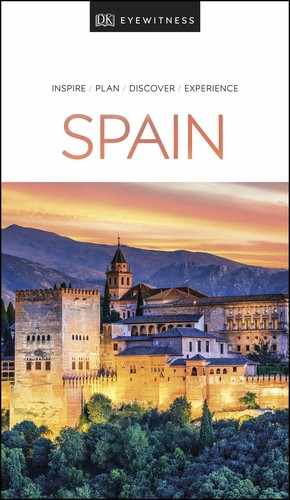Experience More
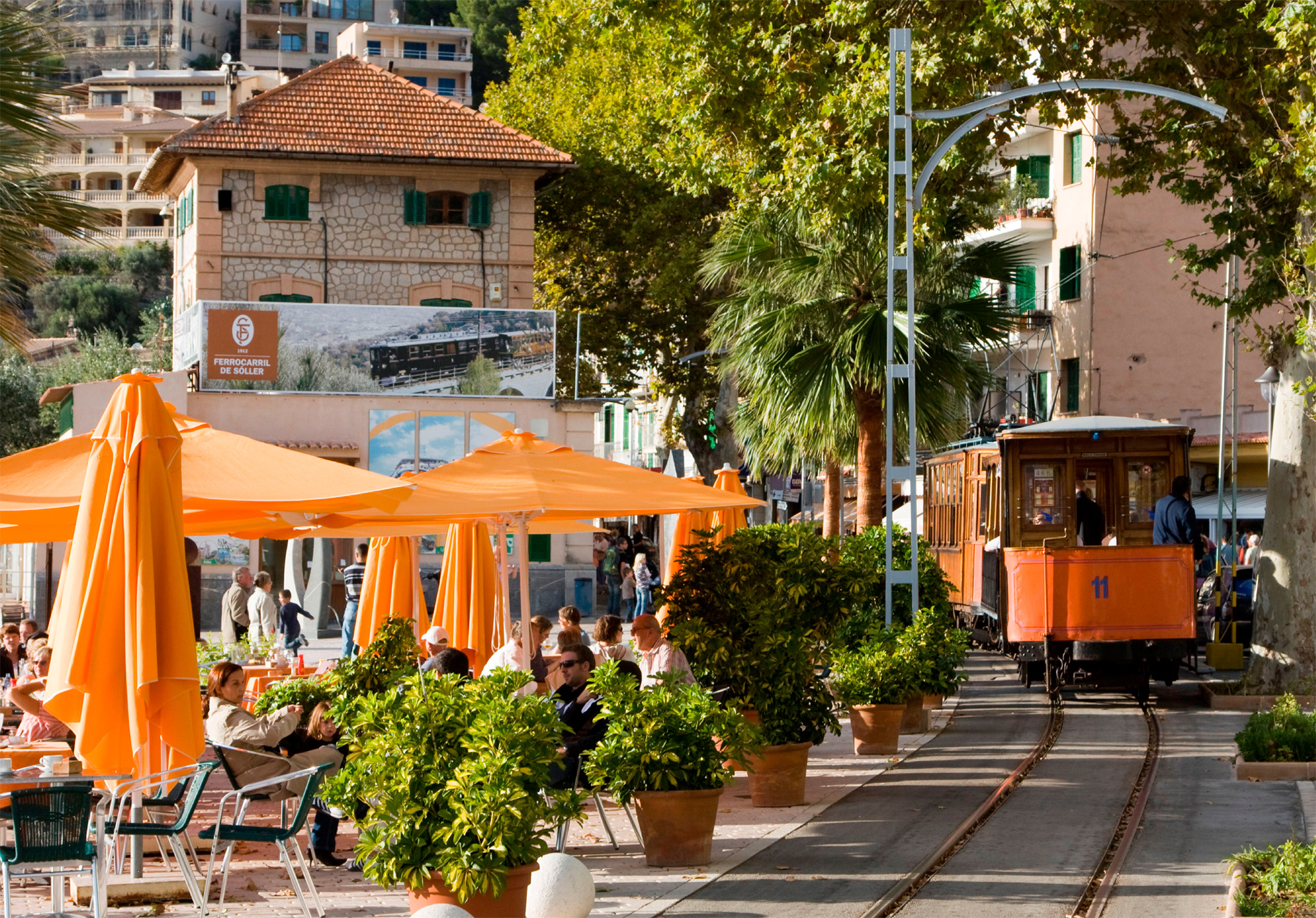
t A charming narrow-gauge train arriving at PlaÇa d'Espanya in Sóller
Sóller is a little town grown fat on the produce of its olive groves and orchards, which climb up the slopes of the Sierra Tramuntana. In the 19th century Sóller traded its oranges and wine for French goods, and the town retains a faintly Gallic, bourgeois feel.
One of Sóller’s best-known features is its delightfully old-fashioned narrow-gauge railway, complete with quaint wooden carriages. The train departs from Palma and ends in Sóller, at the station in the Plaça d’Espanya. From there, an antique tram travels to the fishing village of Port de Sóller, 5 km (3 miles) to the west.

Hidden Gem
Seize the Deià
Tucked away on Mallorca’s northern coast, in the foothills of the Puig del Teix mountain between Sóller and Valldemossa, lies the sleepy village of Deià. This extremely picturesque village is well worth a visit.
This pleasant mountain town is linked with George Sand, the French novelist who stayed here in the winter of 1838 and 1839 and later wrote unflatteringly of the island in Un Hiver à Majorque. Dearer to Mallorcans is the Polish composer Frédéric Chopin (1810–49), who stayed with Sand at the Real Cartuja de Jesús de Nazaret. “Chopin’s cell”, off the monastery’s main courtyard, is where a few of his works were written, and still houses the piano on which he composed.
Nearby, a 17th-century pharmacy displays outlandish medicinal preparations such as “powdered nails of the beast”. In the cloisters is an art museum with works by Tàpies, Miró and the Mallorcan artist Juli Ramis, as well as Picasso’s The Burial of the Count of Orgaz, inspired by the El Greco painting of the same name.
"
Real Cartuja de Jesús de Nazaret
⌂ Plaça de la Cartuja de Valldemossa # 10am–4:30pm Mon–Sat ¢ Nov–Jan ∑ cartujavalldemossa.com
Very few possessiós in Mallorca are open to the public, which makes Alfàbia worth visiting. The house and garden are an excellent example of a typical Mallorcan aristocratic estate and exude a Moorish atmosphere. Little remains of the 14th-century architecture, but look out for the Mudéjar inscription on the ceiling of the entrance hall and the Hispano-Arabic fountains and pergola.
This small town lies amid a valley of almond groves in the shadow of Puig de Galatzó, the pyramidical mountain which rises to 1,026 m (3,366 ft). With its ochre and white shuttered houses and the old watchtowers perched high on a hill above the town, Andratx is a very pretty place.
The road southwest leads down to Port d’Andratx, 5 km (3 miles) away. Here, in an almost totally enclosed bay, expensive yachts are moored in rows along the harbour and luxury holiday homes pepper the hillsides. In the past, Port d’Andratx’s main role was as the fishing port and harbour for Andratx, but since the early 1960s it has gradually been transformed into an exclusive holiday resort for the rich and famous. When visiting Port d’Andratx, it is a good idea to leave all thoughts of the real Mallorca behind and simply enjoy it for what it is – a chic and affluent resort.
High in the mountains of the Sierra Tramuntana, in the remote village of Lluc, is an institution regarded by many as the spiritual heart of Mallorca. The Santuari de Lluc was built mainly in the 17th and 18th centuries on the site of an ancient shrine. The monastery’s Baroque church, with its imposing façade, contains the stone image of La Moreneta, the Black Virgin of Lluc, said to have been found by a young shepherd boy on a nearby hilltop in the 13th century. The sanctuary is home to a children’s choir, the Blauets, established in the 16th century. The kids sing the “Salve Regina” at 1:15pm Mon–Fri and 11am Sun (unless they are on tour).
The museum, on the first two floors of the main building, displays paintings and medieval manuscripts. As well as the museum, the monastery now houses a guesthouse.
Along the Camí dels Misteris, the paved walkway up to the hilltop where the sanctuary sits, there are some bronze bas-reliefs by Pere Llimona.

t Strolling through the manicured gardens of La Granja estate
La Granja is a private estate near the little country town of Esporles. Formerly a Cistercian convent, it is now the property of the Seguí family, who have opened their largely unspoiled 18th-century house to the public as a kind of living museum. Peacocks roam the gardens, salt cod and hams hang in the kitchen, The Marriage of Figaro plays in the ballroom, and the slight air of chaos just adds to the charm of the place.
EXPERIENCE The Balearic Islands
|
Eat Verico Gourmet Italian food is served at this inviting Port d' Andratx eatery. If you can’t decide between the dishes on offer, try the four-course taster menu ⌂ Avinguda de Gabriel Roca i García 24, Port d’Andratx, Mallorca ∑ verico-portandratx.com ¡¡¡ Kingfisher Make the most of island life by sampling the catch of the day at this excellent seafood restaurant situated at the end of Sóller’s port. ⌂ Calle San Ramon de Penyafort, Port de Sóller, Mallorca ∑ kingfishersoller.com ¡¡¡ |
Mallorca may not be as rich in megalithic remains as neighbouring Menorca, but this Talayotic village is worth seeing. The settlement, which dates back to around 1000 BC, originally consisted of five talaiots (stone tower-like structures with timbered roofs) and another 28 smaller dwellings. Little is known about its inhabitants and the uses for some of the rooms, such as the tiny underground gallery. Too small for living in, this room may have been used to perform magic rituals.
Part of the charm of this place lies in its setting among fields of fruit trees and dry-stone walls. Apart from a snack bar nearby, the site remains undeveloped and quite peaceful.
EXPERIENCE The Balearic Islands

Mallorca Beaches
Cala Formentor
This beautiful beach in the northwest of the island is surrounded by forests and mountains.
Cala Molins
A Sandy blue-flag beach in Cala Sant Vicenç. Perfect for kids.
Cala Deià
Secluded and small, this rocky beach has phenomenal views.
Santa Ponsa
Very popular sandy beach, particularly good for families.
Playa d’Alcúdia
Enormous beach with shallow waters, particularly suitable for families.
In the middle of a fertile plain called the pla, Puig de Randa rises 543 m (1,780 ft). It is said that Mallorca’s greatest son, the 14th-century theologian and mystic Ramon Llull, came to a hermitage on this mountain to meditate and write his religious treatise, Ars Magna. On the way up Puig de Randa there are two small monasteries, the 14th-century Santuari de Sant Honorat and the Santuari de Nostra Senyora de Gràcia, which is built on a ledge under an overhanging cliff.
On the mountaintop is the Santuari de Cura, built to commemorate Llull’s time on the puig, and largely devoted to his work. A small museum, housed in a 16th-century former school off the central courtyard, which is built in the island’s typical beige stone, contains some of Llull’s manuscripts.
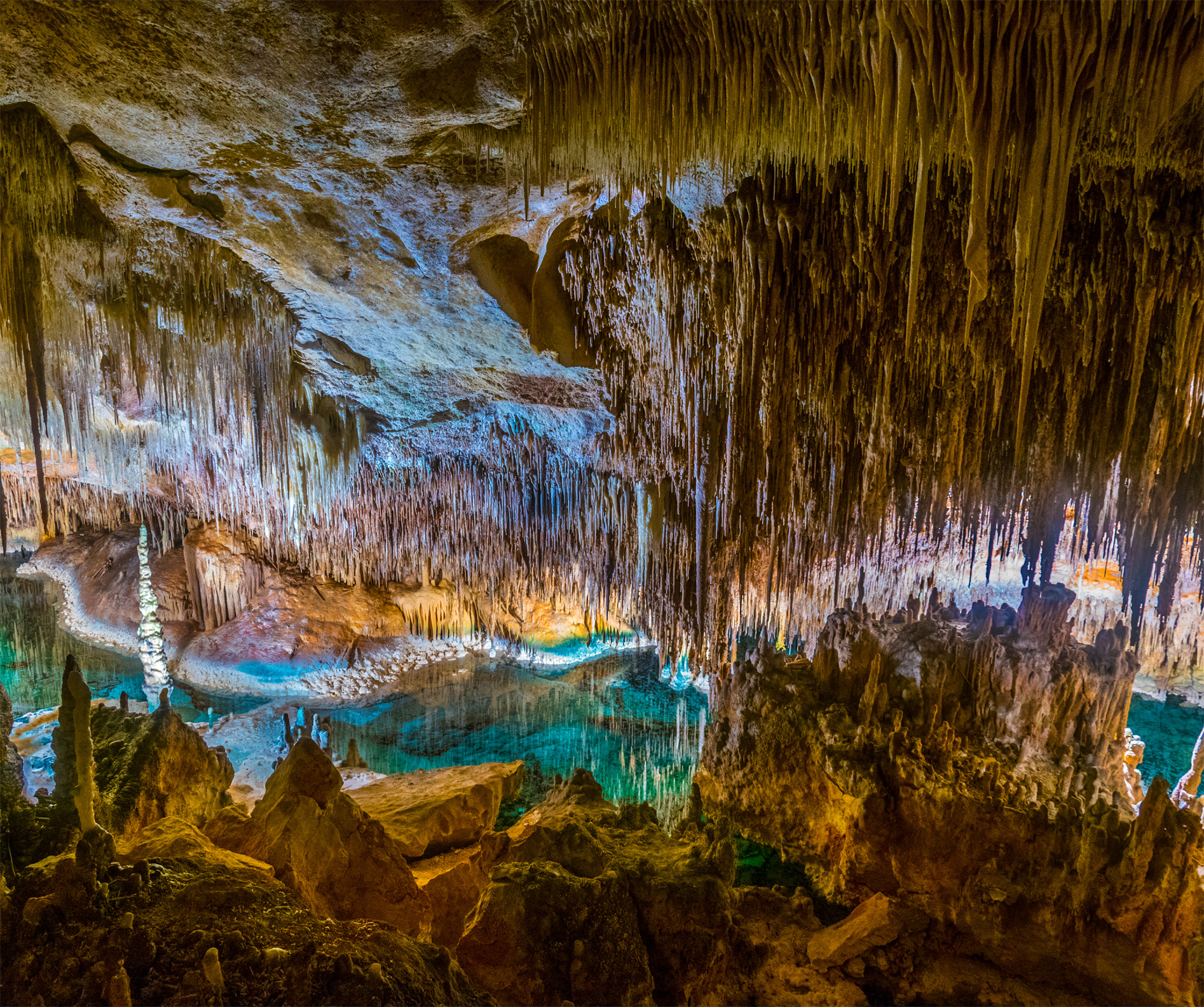
t The dramatically lit stalactites in the Coves del Drac
Mallorca has numerous caves, from mere holes in the ground to cathedral-like halls. The four vast chambers of the Coves del Drac are reached by a steep flight of steps. At the bottom is the beautifully lit cave, “Diana’s Bath”. Another chamber holds the underground lake, Martel, 29 m (95 ft) below ground level and 177 m (580 ft) long. Music fills the air of the cave, played from boats on the lake. Equally dramatic are the two remaining caves, charmingly named “The Theatre of the Fairies” and “The Enchanted City”.
Alongside, the Coves d’Hams are so called because some of their stalactites resemble hooks – hams in Mallorcan. The caves contain the “Sea of Venice”, an underground lake on which musicians sail.
The entrance to the Coves d’Artà is near Capdepera. The caves’ main attraction is a stalagmite 22 m (72 ft) high.
"
Coves d’Hams
⌂ Carretera Manacor–Porto Cristo, km 11.5 # Jul–Oct: 10am–5pm daily; Nov–Jun: 10am–4:30pm daily ¢ 1 Jan, 25 Dec ∑ cuevasdelshams.com
"
Coves d’Artà
⌂ Carretera Coves s/n, Canyamel # Apr–Jun & Oct: 10am–6pm daily; Jul–Sep: 10am–7pm daily; Nov–Mar: 10am–5pm daily ¢ 1 Jan, 25 Dec ∑ cuevasdearta.com
EXPERIENCE The Balearic Islands
|
Stay Hotel Can Mostatxins This boutique is set in a historic building that dates back to the 15th century. The spa and champagne bar bring this Alcúdian hotel firmly into the 21st century. ⌂ Carrer del Lledoner 15, Alcúdia, Mallorca ∑ hotelcanmostatxins.com ¡¡¡ Son Brull A family-run hotel set in an old farmstead near Pollença, Son Brull will give you a taste of rural life on the island. Each of the rooms is tastefully decorated with subtle Mallorcan touches. The on-site restaurant is excellent. ⌂ Carretera Palma–Pollença (PM-220), km 49.8, Pollença, Mallorca ∑ sonbrull.com ¡¡¡ |
This bustling agricultural town is visited mainly for three reasons: the imposing façade of the 13th-century church, the Esglesia de Sant Miquel; its sobrassada de porc negre (a spiced raw sausage made from the meat of the local black pig), and its lively religious fiestas.
With its ochre-coloured stone houses and winding lanes, Pollença is picturesquely sited on the edge of fertile farmland. The town has fine churches, including Convent de Santo Domingo, which houses the Museu de Pollença. A chapel on the hilltop, El Calvari, is reached either by road or a long climb of 365 steps. On the altar there is a Gothic Christ, carved in wood.
Alcúdia, 10 km (6 miles) to the east, is surrounded by 14th-century walls. Here, the Museu Monogràfic de Pollentia exhibits statues, jewellery and other remains found in the Roman settlement of Pollentia, south of Alcúdia.
"
Museu de Pollença
⌂ Carrer Pere J Salas Cànaves s/n § 971 53 11 66 # Summer: 10am–1pm & 5:30–8:30pm Tue–Sat, 10am–1pm Sun; winter: 11am–1pm Tue–Sun
"
Museu Monogràfic de Pollentia
⌂ Carrer de Sant Jaume 30, Alcúdia § 971 54 70 04 # Summer: 9:30am–8:30pm Mon–Fri, 9:30am–2:30pm Sat & Sun; winter: 10am–3pm Tue–Sat

t The cobbled steps to El Calvari, lined with stone houses, in Pollença
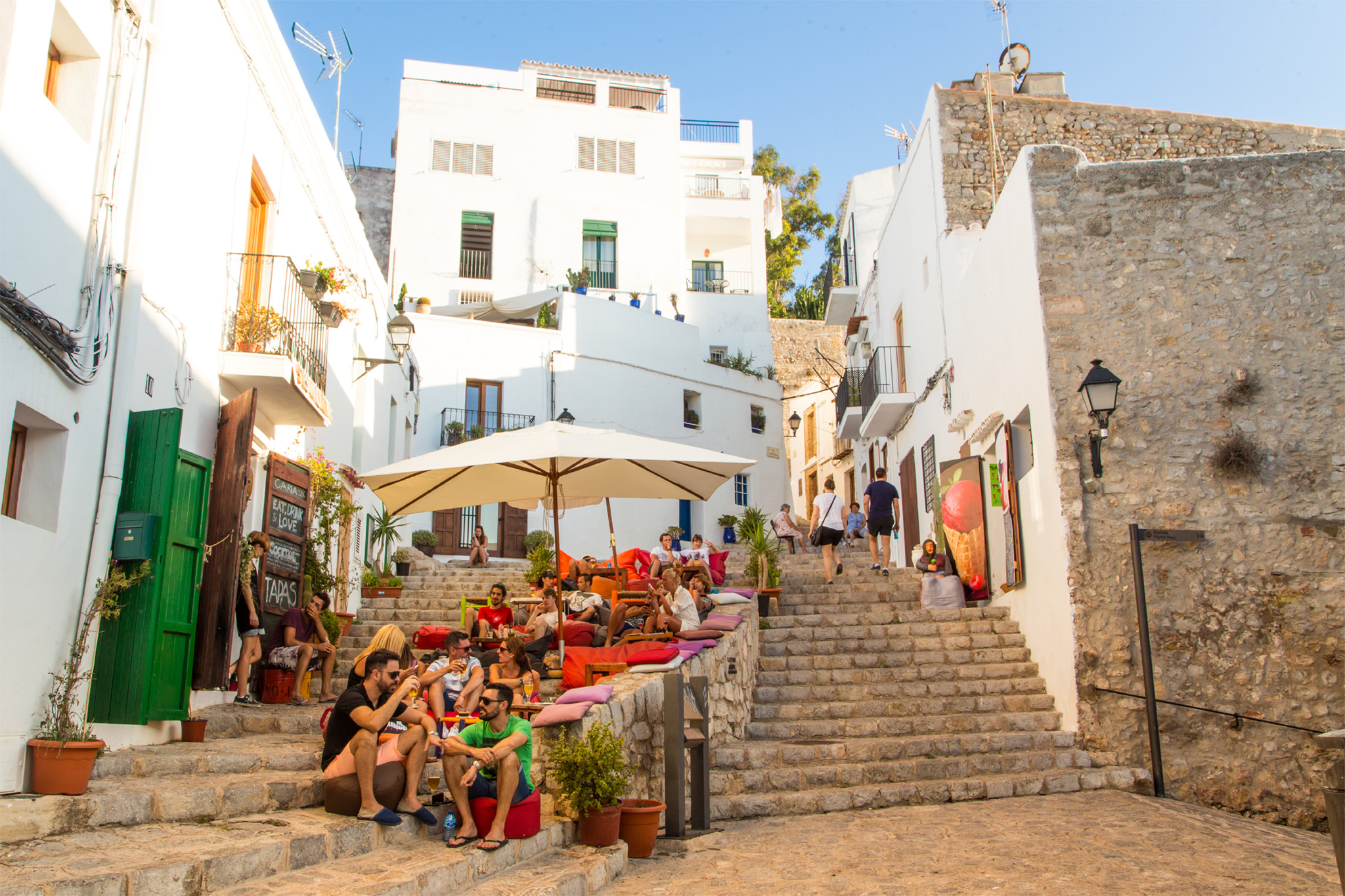
t Visitors relax in a backstreet café, set up on stone steps in the Dalt Vila, Eivissa
The old quarter of Eivissa (Ibiza Town), known as Dalt Vila, is a miniature citadel guarding the mouth of the almost circular bay. The Portal de ses Taules, a magnificent gateway in the north wall of the 16th-century fortifications, carries the finely carved coat of arms of the kingdom of Aragón, to which the Balearic Islands belonged in the Middle Ages.
Inside the walls stands the 16th-century Església de Santo Domingo with its three red-tiled domes. The Baroque interior has a barrel-vaulted ceiling and frescoed walls. Works by Erwin Bechtold, Barry Flanagan and other artists connected with Ibiza are on display in the Museu d’Art Contemporani. Art is also on display in the cathedral’s Museu Diocesà. This 13th-century Catalan Gothic building, with 18th-century additions, crowns
the whole Dalt Vila.
Under the Carthaginians, the soil of Ibiza was considered holy. The citizens of Carthage deemed it an honour to be buried in the Necrópolis Púnica del Puig des Molins. Part of it can be visited by the public.
The crossroads village of Jesús, 3 km (2 miles) north, is worth a visit for its 16th-century church. Originally built as part of a Franciscan monastery, it has a 16th-century altarpiece by Rodrigo de Osona the Younger.
"
Museu d’Art Contemporani
⌂ Ronda Narcís Puget s/n # Hours vary, check website ∑ eivissa.es/mace
Necrópolis Púnica del Puig des Molins
⌂ Via Romana 31 # Apr–Sep: 10:30am–2pm & 6:30–9pm Tue–Sat, 10am–2pm Sun; Oct–Mar: 9:30am–3pm Tue–Sat, 10am–2pm Sun ¢ Public hols ∑ maef.es
Did You Know?
Sant Josep’s Sublimotion is the world’s most expensive restaurant, charging €1,500 per head.
The charming village of Sant Josep, the administrative centre of southwest Ibiza, lies in the shadow of Ibiza’s highest mountain. At 475 m (1,560 ft), Sa Talaiassa offers a panorama of all Ibiza, including the islet of Es Vedrá, rising from the sea like a rough-cut pyramid.
For the most accessible view of this enormous rock, take the coastal road to the sandy cove of Cala d’Hort, where there are a number of good restaurants and a quiet beach.
Sant Josep is still a traditional village with a good choice of restaurants and bars. The main street has an impressive church where you can sit in the shade of the courtyard trees.
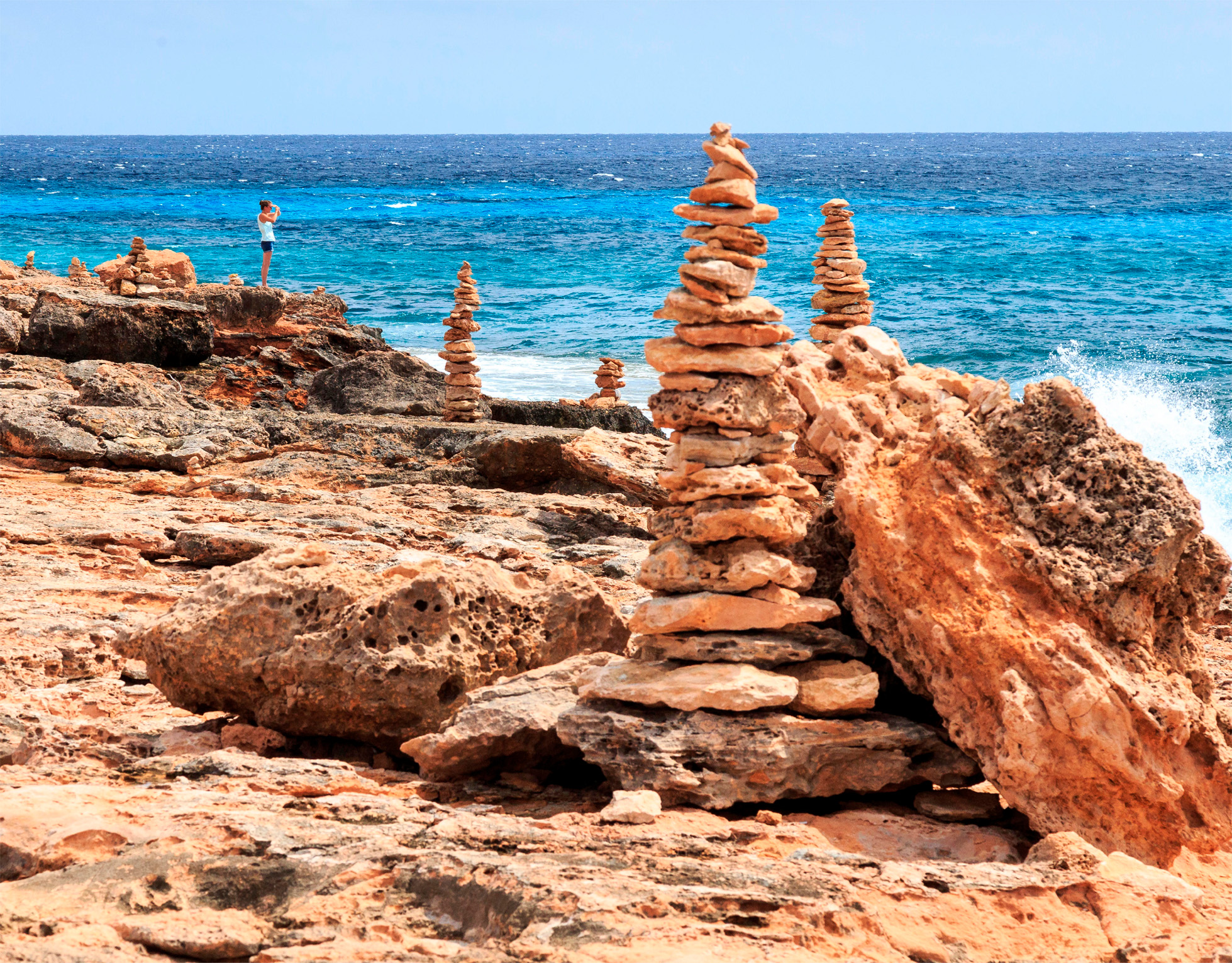
t Piles of stacked stones on a rocky beach in Ses Salines, the saline lowlands
Situated at the southern end of Ibiza are the saline lowlands called Ses Salines. These natural saltpans provide an extremely important refuge for the local wildlife, and were known as the “Salt Gardens” in Phoenician times.
They are sheltered to the north by the Serra Grossa hills, which rise up to 160 m (520 ft) in some places; to the south they are flanked by the wooded areas of Faló and Corbari. In 1992, the area was given special protection as a nature reserve.
Before tourism, for centuries the revenue from the local salt production provided a large chunk of the island’s income. Until quite recently, the place was served by a narrow-gauge railway carrying salt to La Canal – a small port at the southern end of the peninsula. Salt production still continues at Ses Salines, though not on such a grand scale – some 70,000 tonnes of the stuff are exported each year.
Built between the salt lakes is the village of Sant Francesc de S’Estany, where some salt workers still live, which has a small picturesque church. The asphalt road that passes the church leads to a 16th-century watchtower, Torre de sa Salt Rossa, 2 km (1 mile) away. From here there are fine views over nearby Illa Sal Rossa island, the wide beaches of Figueretes (lying to the south of the capital) and Dalt Vila (Old Town) in Eivissa.
Ses Salines’ beach, Platja de Ses Salines, is one of the island’s most fashionable spots. This long, crescent-shaped sandy beach is bordered by pine woods and has crystal-clear water.
EXPERIENCE The Balearic Islands
|
Eat Bebel An Italian-style Eivissan restaurant, offering both cooked and raw seafood. Tasting menus are available. ⌂ Carrer de Jaume I 4, Eivissa, Ibiza § 633 50 04 62 ¡¡¡ Tapas Ibiza Set away from San Antoni de Portmany’s busy strip, this lovely restaurant serves tapas, some traditional, some innovative. ⌂ Camino des Reguero 4, San Antoni de Portmany, Ibiza ∑ tapasibiza.com ¡¡¡ Montauk Steakhouse This gorgeous steakhouse is found in Sant Jordi Ses Salines. Here, you can enjoy great food with a nice view of the beach. ⌂ Carretera Platja d’en Bossa 10, Sant Jordi Ses Salines, Ibiza ∑ theushuaiaexperience.com ¡¡¡ La Paloma A postcard-pretty garden restaurant, near Eivissa, offering dishes made using organic, local ingredients. The menu features a small range of Italian-inspired dishes. ⌂ Carrer can Pou 4, Sant Llorenç de Balàfia, Ibiza ∑ palomaibiza.com ¡¡¡ |

t Savannah café, overlooking the water on the famous Sunset Strip at Sant Antoni
Ibiza’s second town, Sant Antoni was known by the Romans as Portus Magnus because of its large natural harbour. Formerly a tiny fishing village, it has turned into a sprawling and exuberant resort. Although it was once over-commercialized, the town has undergone a dramatic face-lift. Nevertheless, the 14th-century parish church of Sant Antoni is practically marooned in a sea of modern high-rise hotels.
To the north of Sant Antoni, on the road to Cala Salada, is the chapel of Santa Agnès, an unusual early Christian temple (not to be confused with the village of the same name). When this catacomb-like chapel was discovered, in 1907, it contained Moorish weapons and fragments of pottery.
'Did You Know?
Sant Antoni ‘s upright egg statue depicts how Columbus proved that he could sail to India.
Els Amunts is the local name for the uplands of northern Ibiza, which stretch from Sant Antoni on the west coast to Sant Vicenç in the northeast. Though hardly a mountain range – Es Fornás is the highest point, at a mere 450 m (1,480 ft) – the area’s inaccessibility, due to the lack of infrastructure, has kept Els Amunts virtually unspoiled.
There are very few cultural sights here, apart from the landscape, which consists of pine-clad hills sheltering fertile valleys whose rich red soil is planted with olive, almond and fig trees, and the occasional vineyard. Tourist enclaves are scarce, except for a handful of small resorts, such as Port de Sant Miquel, Portinatx and Sant Vicenç.
Inland, villages like Sant Joan and Santa Agnès offer an insight into Ibiza’s quiet, rural past. When the almond trees bloom in February, islanders gather in Santa Agnès to admire this spectacle as the whole of the valley is swathed in a covering of silvery-white.
Situated between Santa Agnès and San Antoni, inside the Ses Fontanelles cave are prehistoric paintings, discovered in 1917 by French archaeologist Henri Breuil. Recent studies date them to the Punic era. The cave is not accessible by the public but there are replicas on site that can be seen from the outside.
The architectural high points of northern Ibiza are several beautiful white churches, like the one in Sant Miquel, which, on Thursdays in summer, is host to a display of Ibizan folk dancing. Outside Sant Llorenç is the tranquil, fortified hamlet of Balàfia, with flat-roofed houses, tiny whitewashed alleys and a watchtower that was used as a fortress during raids by the Turks.
EXPERIENCE The Balearic Islands

Ibiza Beaches
Platja de Ses Salines
A long sandy beach, which is part of a conservation area.
Cala Benirràs
Lively party beach, often with live music
Cala Xarraca
Crystal-clear waters near Portinatx, perfect for snorkelling.
Talamanca
Walking distance from Eivissa, a favourite beach for sunbathing.
Cala Llonga
Large sandy beach near Eivissa, particularly popular with families.

t The domed roof of Santa Eulària’s whitewashed 16th-century church
The characterful town of Santa Eulària des Riu is sited on the island’s only river. Its 16th-century church, with its covered courtyard, and the surrounding Old Town were built on the top of a little hill, the Puig de Missa, because this site was more easily defended than the shore below.
Adjacent to the church is the Museo Etnológico de Ibiza y Formentera, a folk museum housed in an Ibizan farmhouse. The exhibits include traditional costumes, farming implements, toys and an olive press. A collection of photographs covering 50 years shows how Ibiza has changed.
Two art and craft markets, Punta Arabí (Wed) and Las Dalias (Sat), are held just outside of town and feature hundreds of stalls.
" '
Museo Etnológico de Ibiza y Formentera
⌂ Can Ros, Puig de Missa § 971 33 28 45 # Apr–Sep: 10am–2pm & 5–8pm Tue–Sat, 11am–1:30pm Sun; Oct–Mar: 10am–2pm Mon–Sat, 11am–1pm Sun ¢ Mid-Dec–31 Jan
EXPERIENCE The Balearic Islands
|
Drink Amnesia An Ibiza megaclub considered one of the best in the world. If you’re on the island for the clubs, don’t skip this one in San Rafael. ⌂ Carretera Ibiza a San Antonio, km 5, San Rafael, Ibiza ∑ amnesia.es Liquido Cocktail Bar Overlooking Santa Eulària’s marina, this cool bar serves great cocktails accompanied by northern soul and Motown music. ⌂ Marina, Santa Eulària des Riu, Ibiza § 609 57 22 60 Popeye’s Bar This lively bar in Santa Eulària serves food and drink throughout the day. You’ll enjoy the live entertainment. ⌂ Carretera Cala Nova Es Canar, Santa Eulària des Riu, Ibiza § 971 33 90 67 |
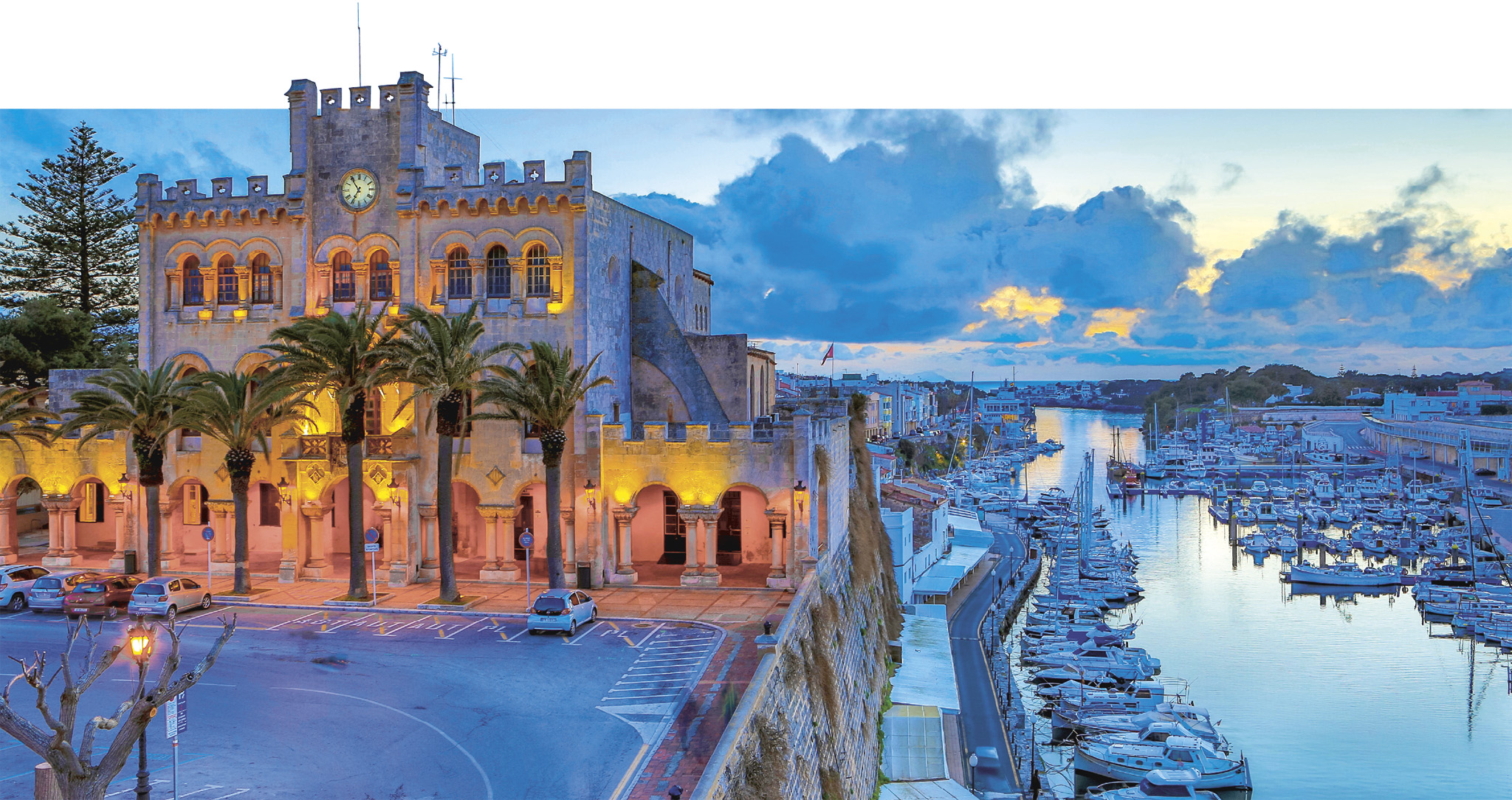
t Looking down on the seafront from Ciutadella’s Plaça des Born
The key date in the history of Ciutadella is 1558. In that year the Turks, under Barbarossa, entered and decimated the city, consigning 3,495 of its citizens to the slave markets of Constantinople. Of Ciutadella’s main public buildings, only the fine Catalan Gothic Església Catedral de Menorca managed to survive this fearsome onslaught in more or less its original condition, only later to be stripped of all its paintings, ornaments and other treasures by Republican extremists during the Civil War.
The nearby Plaça des Born was built as a parade ground for Moorish troops, and from 1558 was gradually rebuilt in Renaissance style. Today it is one of Spain’s most impressive squares, containing pleasant cafés and bordered by shady palm trees. At the centre of the Plaça des Born is an obelisk which commemorates the “Any de sa Desgràcia” (Year of Misfortune), when the Turks invaded the city. Around the square are the late 19th-century Teatre Municipal des Born, and a series of aristocratic mansions with Italianesque façades, the grandest of which is the early 19th-century Palau de Torre-Saura. Another one of these impressive palaces, the Palau Salort, houses Ciutadella’s ajuntament (town hall). At set times during the year, you can explore the preserved rooms of this Gothic-style palace, including the kitchen, which has beautiful tiles. From the northern end of the square there is a fine view over the small harbour.
If you walk up the Carrer Major des Born past the cathedral, you come to Ses Voltes, an alley lined on both sides by whitewashed arches. Turn right along the Carrer del Seminari for the Baroque Església dels Socors and the Museu Diocesà with its displays of ecclesiastical paraphernalia. The Art Nouveau market, which dates from 1895 and is painted dark green, stands nearby.
The peace of Ciutadella is disturbed every June by the Festa de Sant Joan, a spectacular ritual of horsemanship. During the festival the local gin (ginebra) is drunk copiously and the city comes to a grinding halt.
" '
Museu Diocesà
⌂ Carrer del Seminari 7 § 971 48 12 97 # May–Oct: 10:30am–1:30pm Tue–Sat
"
Palau Salort
⌂ Plaça des Born 9 # May–Oct: 10am–4pm daily ¢ Nov–Apr

Hidden Gem
Lithica
Only a few kilometres from Ciutadella, you can visit a restored old quarry, which shows the history of stonework on the island. Equally impressive here are the beautiful medieval gardens.
At 142 m (466 ft) above sea level, this picturesque little town is the highest settlement in Menorca. Its name derives from the many blacksmiths (ferreries) who once worked around here. At the heart of the town is the Plaça d’Espanya. Here, at a weekly Saturday market, you can buy leather goods as well as produce brought in by local farmers, including vegetables, fruit, cheese and honey. In Plaça l’Església is the parish church of Sant Bartomeu and the town hall. It is also worth stepping into the Centro de Geologia de Menorca, to see a selection of the island’s natural wonders.
About 6 km (4 miles) to the north of Ferreries is the Santa Agueda castle. Not much remains of this Moorish stronghold, but the view from the top of the third-highest hill in Menorca justifies the climb up to the fortress.
The bay of Santa Galdana, 10 km (6 miles) to the south of Ferreries, is even prettier. You can take a pleasant walk from the beach inland through the fertile riverbed of Barranc d’Algendar.
EXPERIENCE The Balearic Islands
|
Eat Piqniq This great little sandwich bar in Ciutadella offers a selection of picnic food. It’s the perfect place for a bite on the go, or to buy food for the beach. ⌂ Calle Sant Pere 7, Ciutadella, Menorca § 971 48 23 54 ¡¡¡ Cuk-Cuk Dining at this Ciutadella eatery, self-styled as a “restaurant for foodies”, is an unusual experience. You decide what to have from the menu, then cook it yourself with guidance from the chef. ⌂ Calle de Sant Pere Alcantara 13, Ciutadella, Menorca ∑ cuk-cuk.com ¡¡¡ Marlet Grill Barbacoa A quirky little Fornells restaurant, serving just about anything that can be cooked on a barbecue, accompanied by great cocktails, delicious wine or cold beer. It’s only open during the high season, so call ahead. ⌂ Carrer de Baix s/n, Fornells, Menorca § 971 37 67 98 ¡¡¡ |
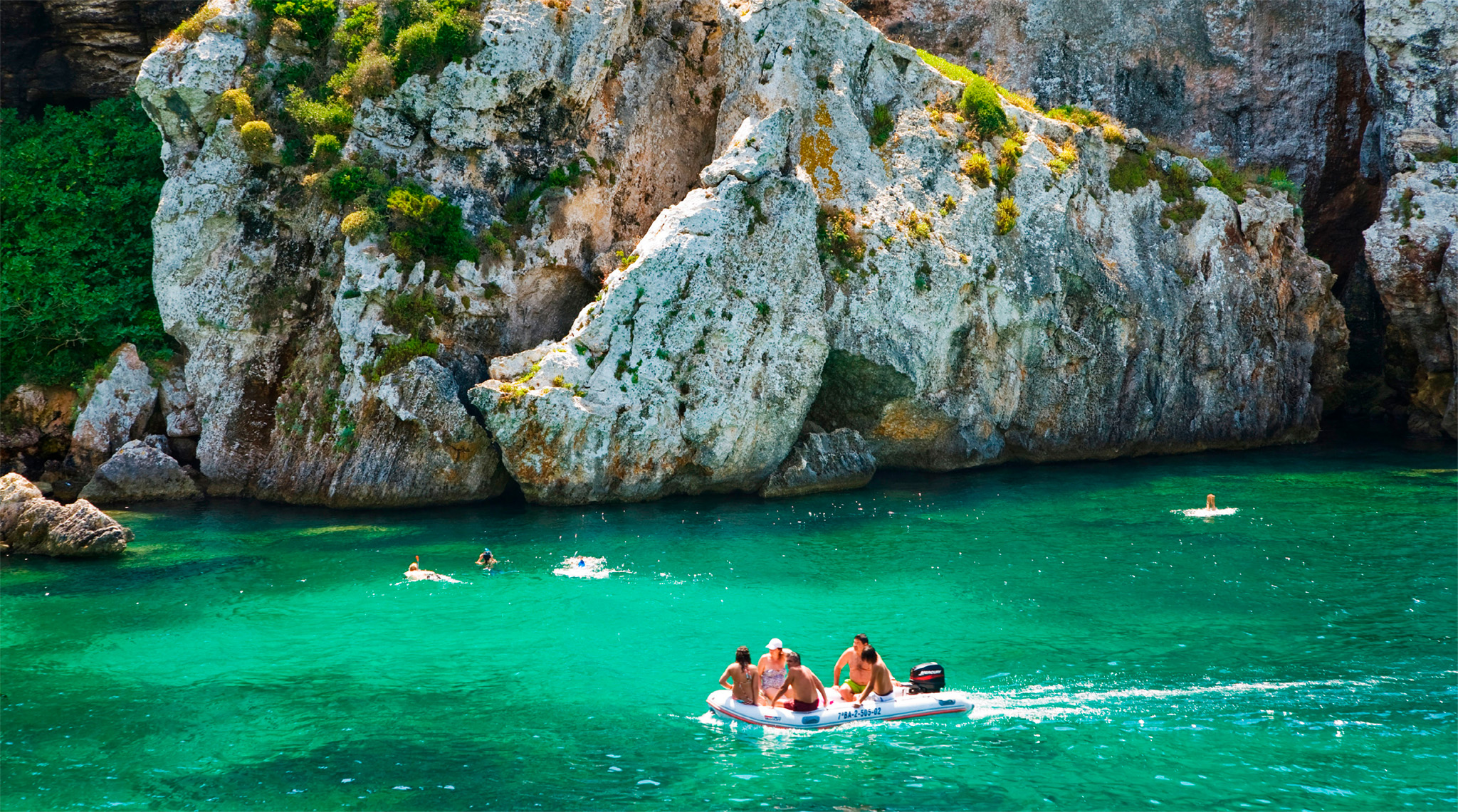
t Exploring the Cales Coves
On either side of a pretty bay can be found Cales Coves – the site of Neolithic dwellings of up to 9 m (30 ft) in length, hollowed out of the rock face. The caves, thought to have been inhabited since prehistoric times, are today occupied by a community of people seeking an alternative lifestyle. Some of the caves have front doors, chimneys and even butane cookers.
About 8 km (5 miles) west, along the coast, lies Binibeca, a tourist village built in a style sympathetic to old Menorca. A jumble of white houses and tiny streets, it was designed to look like a poblat de pescadors (fishing village).

t Along the coast from Binibeca
This small country town – one of the three, with Alaior and Ferreries, that are strung out along the main road from Maó to Ciutadella – is unremarkable in itself, but within reach of it are three places of interest.
El Toro, 3 km (2 miles) to the east, is Menorca’s highest hill, at 350 m (1,150 ft). It is also the spiritual heart of the island and at its summit is the Santuari del Toro, built in 1670, which is run by nuns.
About 10 km (6 miles) north of Es Mercadal, the fishing village of Fornells transforms itself every summer into an outpost of St Tropez. In the harbour, smart yachts jostle with fishing boats, and the local jet-set crowd into the Bar Palma. Fornells’ main culinary speciality is the caldereta de llagosta (lobster stew), but the quality varies and prices can be high.
The road-cum-dirt-track to the Cap de Cavalleria, 13 km (8 miles) north of Es Mercadal, passes through one of the Balearics’ finest landscapes. Cavalleria is a rocky promontory, whipped by the tramontana wind from the north. It juts out into a choppy sea which, in winter, looks more like the North Atlantic than the Mediterranean. At the western edge of the peninsula are the remains of Sanisera, a Phoenician village mentioned by Pliny in the 1st century AD. The road leads to a headland, with a lighthouse and cliffs 90 m (295 ft) high, where peregrine falcons, sea eagles and kites ride the wind.
Further west along the coast is a string of fine, unspoiled beaches: La Vall d’Algaiarens, Cala Pregonda and Cala del Pilar are three of the best.
The quietly elegant city of Maó has lent its Spanish name, Mahón, to mayonnaise. It was occupied by the British three times during the 18th century. The legacy of past colonial rule can be seen in sober Georgian town houses, with their dark green shutters and sash windows.
Maó’s harbour is one of the finest in the Mediterranean. Taking the street leading from the port to the upper town, you come to the 18th-century Església del Carme, a former Carmelite church whose cool white cloister is now the setting for a fruit and vegetable market. Behind the market is the Col·lecció Hernández Sanz y Hernández Mora, which houses Menorcan art and antiques. The nearby Plaça Constitució is overlooked by the church of Santa Maria, which has a huge organ. Next door is the town hall, with its Neo-Classical façade, adorned by the famous clock donated by Sir Richard Kane (1660–1736), the first British governor of Menorca.
Located at the end of the Carrer Isabel II is the Església de Sant Francesc, with an intriguing Romanesque doorway and Baroque façade. This is the venue for the Museu de Menorca, which explores the island’s Talayotic past. Two minutes’ walk south of here will take you to the Plaça de S’Esplanada, behind which is the Ateneu de Maó. Inside are collections of local ceramics and maps, and a library. It is advisable to obtain permission before looking around. On the north side of the harbour is a mansion known as Sant Antoni or the Golden Farm. As Maó’s finest example of Palladian architecture, it has an arched façade, painted plum red, with white arches, in the traditional Menorcan style. Nelson, the British admiral, is thought to have stayed here. The house has a collection of Nelson memorabilia and a fine library but is closed to the public.
"
Col·lecció Hernández Sanz y Hernández Mora
⌂ Carrer Anuncivay 2 § 971 35 65 23 # May–Oct: 10am–1:30pm & 6–8pm Tue–Sat, 10am–1:30pm Sun; Nov–Apr: 10am–1.30pm & 6–8pm Thu–Sat, 10am–1.30pm Tue, Wed & Sun
Museu de Menorca
⌂ Plà des Monestir 9 # 10am–1:30pm & 6–8pm Tue & Thu, 10am–2pm Wed, Fri, Sat & Sun ∑ museudemenorca.com
Ateneu de Maó
⌂ Carrer Rovellada de Dalt 25 § 971 36 05 53 # Summer: 9am–2pm Mon–Fri; winter: 4–9:30pm Mon–Fri
EXPERIENCE The Balearic Islands
Ancient Menorca

Exceptionally rich in prehistoric remains, Menorca has been described as an immense open-air museum. The majority of the sites are the work of the Talayot people who lived between 2000 BC and 1000 BC and are named after the talaiots or huge stone towers that characterize the Menorcan landscape. There are hundreds of these Bronze Age villages and structures dotted around the island. Usually open to the public and free of charge, these sites provide an invaluable insight into the ancient inhabitants of the Balearic Islands.

t The harbour on Cabrera island, watched over by the fortress on the hill above
From the beaches of Es Trenc and Sa Ràpita, on the south coast of Mallorca, Cabrera looms on the horizon. The largest island in an archipelago of the same name, it lies 18 km (11 miles) from the most southerly point of Mallorca. Cabrera is home to rare plants, reptiles and sea birds, such as Eleonora’s falcon. The waters are important for marine life. All this has resulted in it being declared a national park. Cabrera was once used as a military base and it has a small population. On it stands a 14th-century castle and a simple inn.
EXPERIENCE The Balearic Islands
|
Stay Hotel Entre Pinos There’s a great breakfast, pool and spa at this Formentera option. ⌂ Avenida Mola, km 12.3, Es Calo, Formentera ∑ hotelentrepinos.es ¡¡¡ Sa Volta Hotel This Formentera hotel offers an elegant stay. The rooftop pool has excellent views. ⌂ Avenida Miramar 94, Es Pujols, Formentera ∑ savolta.com ¡¡¡ |
An hour’s boat ride from Ibiza will bring you to this unspoiled island where waters are blue and the way of life is slow.
From the small port of La Savina, there are buses to other parts of the island, or you can hire a car, moped or bicycle from one of the shops.
Sant Francesc Xavier, Formentera’s tiny capital, is situated 3 km (2 miles) from La Savina. Most of the island’s amenities are in this town. From Sant Francesc, a bumpy minor road leads southwards, ending at Cap de Barbaria, the site of an 18th-century defensive tower and a lighthouse.
From the fishing port of Es Caló de Sant Agustí the road winds upwards past the Restaurante Es Mirador, with its panoramic view, to the village of Nostra Senyora del Pilar de la Mola on top of the plateau. About 3 km (2 miles) to the east is a lighthouse, Far de la Mola. Nearby stands a monument to Jules Verne (1828–1905), who used Formentera for the setting of his novel Hector Servadac.
One sight worth seeking out is the megalithic sepulchre of Ca Na Costa (2000 BC) near Sant Francesc, the only one of its kind in the Balearics. This circle of upright stone slabs predates the Carthaginians.
The island’s great strength is its landscape, which has some of the Mediterranean’s last unspoiled shorelines. Two of the finest beaches are Migjorn and Cala Sahona, southwest of Sant Francesc. Illetes and Llevant are two beautiful beaches on either side of a long sandy spit in the far north of the island. To the north is the island of Espalmador, with its natural springs.
EXPERIENCE The Balearic Islands

Balearic Fiestas
Sant Antoni Abat
Parades and the blessing of animals, on Mallorca and Ibiza 16–17 January.
Sant Joan
In Ciutadella (Menorca) on 24 June, elegantly dressed riders put their horses through medieval manoeuvres.
Sant Joan Pelós
A man dresses in sheepskin to represent John the Baptist in Felanitx (Mallorca) on 24 June.
Our Lady of the Sea
Formentera’s main fiesta honours the Virgen del Carmen, patroness of fishermen, with a flotilla of fishing boats on 16 July.
EXPERIENCE The Balearic Islands
FORMENTERA’S BEACHES
The beaches of Formentera can easily rival those of Ibiza. The unspoiled natural environment, magnificent sand and clean waters attract an increasing number of visitors. Most have no hotels or clubs nearby and only a few feature bars or restaurants, which for many people only adds to their charm.

t A sheltered corner of a secluded beach near the fishing village of Es Caló de Sant Agustí
Outdoor Activities
If the thought of just flopping on the sand gives you itchy feet, there are plenty of opportunities to be active on Formentera’s beaches. Although the conditions for windsurfing are not as impressive here as they are in the Canary Islands, the gentler winds makes Formentera’s beaches a good place for beginners to pick up some basic techniques. Take a lesson with Wet4Fun on Es Pujols beach (www.wet4fun.com). They also offer sailing courses for a range of ages and abilities, kayaking and stand-up paddleboarding (SUP). Need to chill out? Why not opt for SUP yoga.
Prefer to be underwater? Formentera’s clear, clean waters, combined with the diversity of marine life, creates the ideal conditions for diving. Every seaside resort has at least one centro de buceo (diving centre), but our favourite is Vellmari Formentera diving in La Savina (vellmari.com).
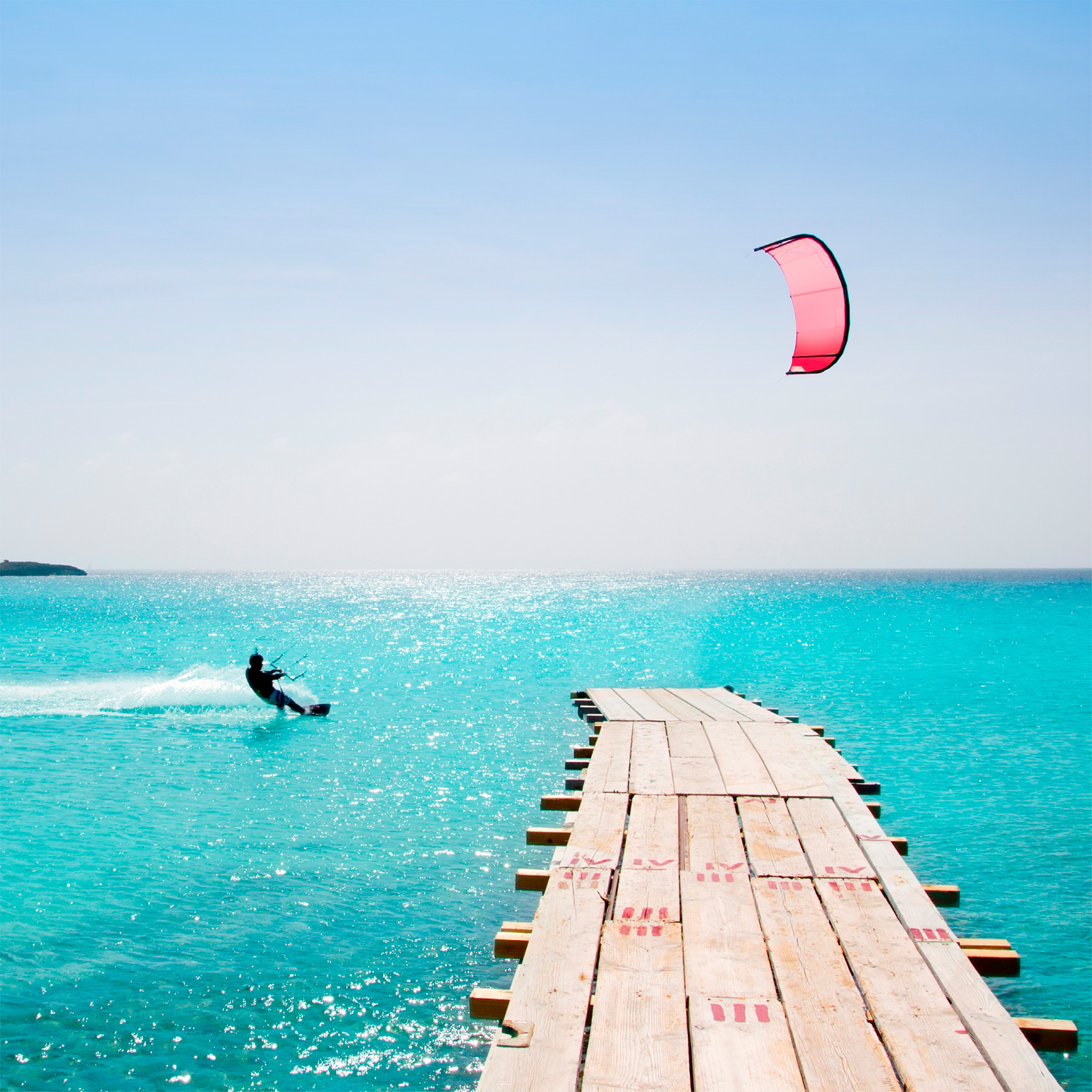
t Windsurfing on the turquoise waters off Formentera
EXPERIENCE The Balearic Islands

Formentera beaches
Platja de ses Illetes
The most popular beach on the island. The Es Trucadors peninsula stretches to the north.
Platja de Llevant
This beach, occupying the eastern side of the peninsula, is much quieter than Platja de ses Illetes.
Platja de sa Roqueta
Situated next to the only hotel in this area, this beach connects to Platja de Llevant so is perfect for beach walks.
Platja de Tramuntana
A number of small, secluded beaches are tucked among the rocks here.
Es Caló de Sant Agustí
The beaches near this fishing village can be reached via the footbridges that cross the thickets covering the dunes.
